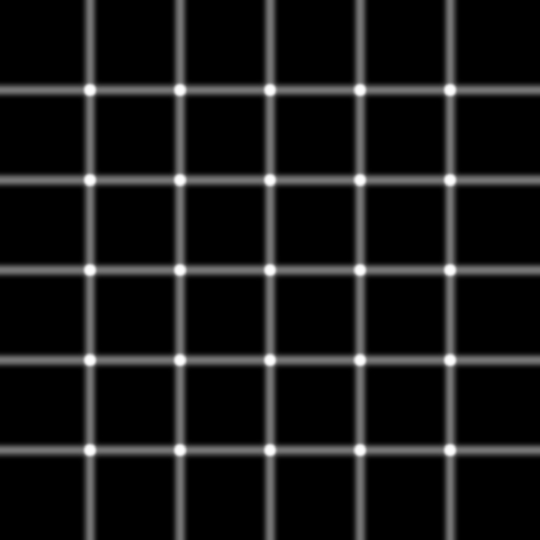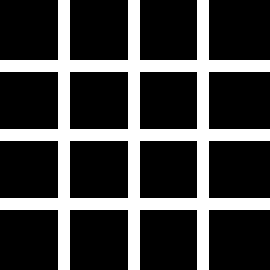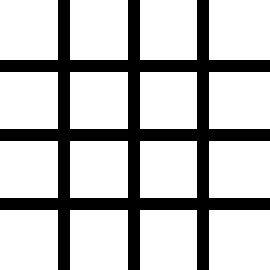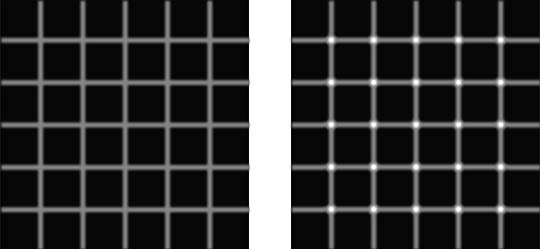
Look at the flashing black dots and learn more about the Hermann Grid and the Scintillation Effect
If you look at the title picture with your eyes wide open, dark black spots suddenly flash in some of the white circles where the lines intersect. They come and go as you allow your gaze to wander. They cannot be fixed, for as soon as you concentrate on one partially white circle the black spot inside immediately disappears. If you only look at the picture with one eye, the black spots occur less frequently. This phenomenon was discovered in 1985 by J. R. Bergen [1] and no satisfactory explanation for it has been found to date.
The grey dots in the intersections in the left-hand picture do not really exist. They merely occur in the head of the viewer.


This effect is a result of the organisation of the receptive fields of the retina and can be explained by lateral inhibition between neighbouring retinal cells which register signals from neighbouring white and black elements of the image. A black environment increases the perception of a white centre and vice-versa. The white intersections have in compassion with the white paths a reduced black environment and thus play host to grey spots. These only occur on the periphery of our range of vision, that is to say never at an intersection in our direct line of vision, which is depicted at the central fovea where our vision is the sharpest. The receptive fields*) of the central fovea are small, while those outside it are large. Since a white intersection in our line of vision is registered by a wealth of tiny receptive fields, the inside always remains white, and thus the ghostly black spot disappears as soon as we attempt to look at it more closely. If the paths are spread out to such an extent that they cover several receptive fields in the transverse direction, the phenomenon vanishes completely.
If black and white are swapped over in the drawing (see illustration on right), the illusion is reversed: now light spots are perceived on the peripheral black intersections and the intersection in the direction of vision remains black for the reasons quoted above. Ludimar Hermann discovered this contrast phenomenon in 1870, when he was professor of physiology at the University of Zurich, and it has become world famous [2]. Some 100 years later at the same research institute, Professor Guenter Baumgartner (and a little later Lothar Spillmann) used this grid as an instrument to measure the size of the receptive fields of the human retina [3]. The later Nobel prize-winners D.H. Hubel and T.H. Wiesel owe some of their success to the pioneering achievements of G. Baumgartner.
*) The receptive field of a nerve cell in the visual system is the area of the retina in which a change in the intensity of a stimulus leads to a change in the cell's firing rate.
In 1941, Walter Ehrenstein left blank the intersections of the Hermann grid thus creating the classic Ehrenstein illusion [4] that is described in the Appendix to Spot 06. A dynamic, interactive blelb variation of this illusion is shown in the applet to the title page of Spot 06.
In 1994, husband and wife team Elke and Bernd Lingelbach created, in collaboration with Michael Schrauf, a blurred version of the Hermann grid with grey paths and white discs at the intersections [5] thereby optimising the scintillation effect that had been discovered in 1985. Just before Christmas 2000, an amusing e-mail with this new grid went around the world in connection with the controversy surrounding the US presidential election results in Florida. It asked recipients to count the number of black spots (votes for Al Gore) and the number of white intersections that remained (votes for George W. Bush) [6].
(For how to go cross-eyed see Spot 11.)

The two illustrations form the basis for a dichoptic experiment: the two eyes are presented with different images by means of squinting, which when the binocular union of the two sets of retinal information are merged to create a single image. Now the individual picture on the right shows flashing black spots. When the images have merged, the flashing can no longer be seen or occurs only rarely and in a weaker form. We therefore believe that the scintillation effect must be created before the images merge while en route to the primary visual centre V1. This effect might be correlated to saccadic eye movements, possible with the microsaccades. The Ehrenstein illusion mentioned above (see Spot 06), on the other hand, only occurs, as similar dichoptic experiments show, of the binocular union and thus clearly has its origins in the cerebral cortex.